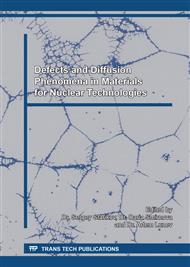[1]
El-Genk, M, Tournier, J., A review of refractory metal alloys and mechanically alloyed-oxide dispersion strengthened steels for space nuclear power systems, Journal of Nuclear Materials 340, 1 (2005), 93-112.
DOI: 10.1016/j.jnucmat.2004.10.118
Google Scholar
[2]
Lundberg, L.B., Los alamos scientific laboratory: progress report (1980), 5-9.
Google Scholar
[3]
Gottstein, G., Physical foundations of materials science (2004).
Google Scholar
[4]
Arsenlis, A., Cai, W., Tang, M., Rhee, M., Oppelstrup, T., Hommes, G., Pierce, T. G., and Bulatov, V. V., Enabling strain hardening simulations with dislocation dynamics, Modelling and Simulation in Materials Science and Engineering 15, 6 (2007).
DOI: 10.1088/0965-0393/15/6/001
Google Scholar
[5]
Devincre, B., Madec, R., Monnet, G., Queyreau, S., Gatti, R., and Kubin, L., Modeling crystal plasticity with dislocation dynamics simulations: The microMegas, code, Mechanics of Nanoobjects 1, 1 (2011), 81-99.
Google Scholar
[6]
Krasnikov, V., Kuksin, A., Mayer, A., Yanilkin, A., Plastic deformation under high-rate loading: The multiscale approach, Physics of the Solid State 52, 7 (2010), 1386-1396.
DOI: 10.1134/s1063783410070115
Google Scholar
[7]
Krasnikov, V. S., Mayer, A. E., Yalovets, A. P., Dislocation based high-rate plasticity model and its application to plate-impact and ultra short electron irradiation simulations, International Journal of Plasticity 27, 8 (2011), 1294-1308.
DOI: 10.1016/j.ijplas.2011.02.008
Google Scholar
[8]
Osetsky, Y. N., Bacon, D. J., An atomic-level model for studying the dynamics of edge dislocations in metals, Modelling and Simulation in Materials Science and Engineering 11, 4 (2003), 427.
DOI: 10.1088/0965-0393/11/4/302
Google Scholar
[9]
Domain, C., and Monnet, G., Simulation of Screw Dislocation Motion in Iron by Molecular Dynamics Simulations, Physical Review Letters 95, 21 (2005), 215506.
DOI: 10.1103/physrevlett.95.215506
Google Scholar
[10]
Po, G., Cui, Y., Rivera, D., Cereceda, D., Swinburne, T. D., Marian, J., Ghoniem, N., A phenomenological dislocation mobility law for bcc metals, Acta Materialia 119 (2016), 123-135.
DOI: 10.1016/j.actamat.2016.08.016
Google Scholar
[11]
Terentyev, D., Bonny, G., Domain, C., Pasianot, R. C., Interaction of a 1/2{111} screw dislocation with Cr precipitates in bcc Fe studied by molecular dynamics, Physical Review B - Condensed Matter and Materials Physics 81 21 (2010), 1-12.
DOI: 10.1103/physrevb.81.214106
Google Scholar
[12]
Plimpton, S., Fast Parallel Algorithms for Short - Range Molecular Dynamics, Journal of Computational Physics 117, June 1994 (1995), 1-19.
DOI: 10.1006/jcph.1995.1039
Google Scholar
[13]
Smirnova, D. E., Kuksin, A. Y., Starikov, S. V. Investigation of point defects diffusion in bcc uranium and U-Mo alloys, Journal of Nuclear Materials 458 (2015), 304-311.
DOI: 10.1016/j.jnucmat.2014.12.080
Google Scholar
[14]
Stukowski, A., Visualization and analysis of atomistic simulation data with OVITO-the Open Visualization Tool, Modelling Simul. Mater. Sci. Eng. 18, 1 (2009), 015012.
DOI: 10.1088/0965-0393/18/1/015012
Google Scholar
[15]
Stukowski, A., Bulatov, V. V., Arsenlis, A., Automated identification and indexing of dislocations in crystal interfaces, Modelling and Simulation in Materials Science and Engineering 20, 8 (2012), 085007.
DOI: 10.1088/0965-0393/20/8/085007
Google Scholar
[16]
Wang, G., Strachan, A., Cagin, T., Iii, W. G., Molecular dynamics simulations of 1/2 a screw dislocation in Ta, Materials Science and Engineering 310 (2001), 133-137.
DOI: 10.1016/s0921-5093(00)01739-1
Google Scholar
[17]
Kuksin, A. Y., Yanilkin, A. V., Atomistic simulation of the motion of dislocations in metals under phonon drag conditions, Physics of the Solid State 55, 5 (2013), 1010-1019.
DOI: 10.1134/s1063783413050193
Google Scholar
[18]
Chang, J. P., Cai, W., Bulatov, V. V., and Yip, S., Molecular dynamics simulations of motion of edge and screw dislocations in a metals, Computational Materials Science 23 (2002), 111-115.
DOI: 10.1016/s0927-0256(01)00221-x
Google Scholar
[19]
Leiko E. B., Lotsko D. B., Nadgorny E. M., Trefilov V. I., Temperature dependence of dislocation mobility in molybdenum monocrystal, Physics of the Solid State 9, 5 (1975), 2735-2742.
Google Scholar
[20]
Gilbert, M. R., Queyreau, S., and Marian, J., Stress and temperature dependence of screw dislocation mobility in α-Fe by molecular dynamics, Physical Review B - Condensed Matter and Materials Physics 84, 17 (2011), 1-11.
DOI: 10.1103/physrevb.84.174103
Google Scholar
[21]
U. K. Kocks, A. S. Argon, M. F. Asby, Progress in Materials Science 19, 19 (1975), 1.
Google Scholar


